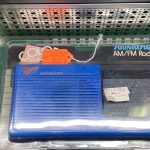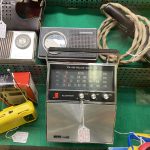Blog post and captions written by: Anonymous in Houston
Photos taken by: Mike
Researched by: Mike & Anonymous in Houston
One thing I like to do when I have some free time is to poke around on Google Maps to see if I can spot any interesting retailers in areas that I don’t visit very often. I was recently browsing the Alvin aerial map to see if I could spot anything interesting. For those unfamiliar with Houston, Alvin is a small community in the far southern part of the Houston metro area. I spotted a big box retail looking building that had a store in it called the Alvin Antique Center & Marketplace. I figured that surely this antique mall must be in a building formerly operated by a major retailer so I zoomed in on the building to see if I could tell what it might have been in a former life.
I then decided to take a look at some interior photos of the antique mall on Google Maps and, wow, I was in for a big surprise! The walls of the antique mall had all kinds of neon signage from what had to have been a supermarket!
Now these are the kind of antiques I like and I’m just talking about the décor of the antique mall! I figured that the previous tenant of the building was a supermarket, but I could not tell which supermarket it might have been. I figured that Houston Historic Retail’s editor, Mike, might have some idea about the history of the building.
The following is a summary of the dialog Mike and I had:
Anonymous in Houston: Do you know who the prior tenant was in this building in Alvin that I’m seeing in Google Maps?
Mike: [After a period of research] It looks like it was Bottom Dollar Store from 1972 to about 1986 and a Super Warehouse Foods from 1994 to about 2002.
Anonymous in Houston: Ok, thanks. I reckon the neon supermarket décor is from Super Warehouse Foods. Oh, by the way, what the heck is a Bottom Dollar Store?!
That’s when the journey started!
I am somewhat familiar with Super Warehouse Foods being a grocer in places in the Houston metro area like Baytown, Pasadena, and Alvin, but I never actually shopped there. In fact, if you read my recent HHR blog post Vintage Ads: AIMing For The Best, you may remember seeing a link to a 1983 ad for the Baytown Super Warehouse Foods in The Baytown Sun newspaper.

Bottom Dollar Stores, however, is a chain I had never heard of before. In fact, none of my Houston retail enthusiast colleagues knew anything about them either. Mike and I immediately started researching them and what we found was very interesting. Although there are still some question marks about them, we were able to find enough information about Bottom Dollar Stores to be able to have a pretty good idea of their history and what kind of store they were.

This might be a big surprise to most Houstonians, but Houston was the home of the headquarters to an operator of chain discount stores, the Bottom Dollar Stores, which operated from around 1962, as you can see from the above Grand Opening ad of their Galveston store that was in The Galveston News (via newspapers.com), to 1987. Bottom Dollar’s initial Galveston store was a mere 6,000 sq. ft. in size, but they later operated stores that were around 50,000 sq. ft. in size. That would have made them pretty similar in size to Wal-Mart Discount City stores in the early 1980s. It seems Bottom Dollar’s soft lines departments were operated under lease by K. Wolens Department Store. This allowed them to sell some fashion brands, like Calvin Klein and Levi’s, that would not normally be available to discount stores.

The probable reason why most Houstonians, even ones who were around during Bottom Dollar’s existence, have never heard of this chain is because the Alvin Bottom Dollar store was the closest location to Houston that operated under the Bottom Dollar name at least. The other Bottom Dollar locations that I know for sure existed were in the small Texas Gulf Coast communities of Galveston, Clute, Wharton, Cuero, Bay City, and Port Lavaca. Angleton had a short-lived Bottom Dollar Store which went on to become a Wal-Mart Discount City just mere weeks after it closed in 1983. It seems probable that Rosenberg had a Bottom Dollar location as well, although the evidence for that location is a little less solid than it is for the other locations.
Bottom Dollar Stores were founded by Joseph Lebow, but the Bottom Dollar Stores were not Lebow’s first attempt at being in the retail business. It seems that Lebow operated a wholesale business named Lebow Wholesale Distributors who helped provide brand name inventory for discount stores doing business in Houston and perhaps elsewhere as well. From what I can gather, Lebow’s warehouse was at 2200 Schlumberger Street in Houston and then later at 9655 W. Tidwell Road in Houston. Since Lebow was used to supplying other discount stores, it seems he decided to try his hand at operating a discount store chain himself given the advantage of him having his own warehouse system based in Houston. It seems Lebow followed Wal-Mart’s strategy of growing from small towns even if Lebow’s business differed from Wal-Mart in the sense that Lebow’s business was based in a major city.
I earlier said that Bottom Dollar never operated stores under their own name in Houston, but it seems that Lebow did try running a concept called Club Warehouse where shoppers could buy merchandise direct from their warehouse on W. Tidwell at presumably big discounts due to low overhead costs. In some ways, the Club Warehouse idea seems somewhat similar, though not completely so, to Wal-Mart’s Sam’s Club division which started operating in 1983 as well. Here’s an ad for Club Warehouse from a 1983 issue of the Houston Chronicle (via NewsBank):

The front page of The Cuero Record for April 2nd, 1971, which is available on the Texas History Portal, has an article describing the Bottom Dollar store that was to come in Cuero.
The Cuero Record for June 10th, 1971 has a photo of the Burns Hospital that was torn down to make room for the Cuero store.
Pages 17 through 24 of the Port Lavaca Wave from January 16, 1984 has an ad for Bottom Dollar showing what kind of products they sold. The last page, page 24, has a listing of Bottom Dollar store locations in 1984.
It seems that the Bottom Dollar stores, and probably the Club Warehouse store as well, all closed between 1986 and 1987. The Port Lavaca Bottom Dollar was probably the last store to close in late summer 1987. The September 2, 1987 Port Lavaca Wave has a “Quitting Business” liquidation sale ad discussing clearing out their Houston warehouse on page 16. Perhaps connected to this is another ad in the very same issue of the Port Lavaca Wave on page 20 discussing the upcoming opening of a Wal-Mart store in the area. Did Bottom Dollar throw in the towel when they knew Wal-Mart was moving into the area? Or did Wal-Mart sense an opportunity to enter that community when Bottom Dollar was moving out? Or maybe the two events were unrelated?

Alvin Antique Center & Marketplace
Now that we’ve gotten to the bottom of Bottom Dollar Stores, we will take a close look at the Alvin Antique Center & Marketplace as it currently exists. Surely the readers of Houston Historic Retail know that we are going to cover a retailer with neon-like lighting especially when the neon signage is completely out of place given the goods being sold at the store in current times! Who knows, maybe some of the products being sold at the antique mall were originally sold at the Bottom Dollar or Super Warehouse Foods stores that operated out of this building. Whatever the case is, the antique store here itself is part of the great antiquing experience!
Mike was able to visit the Alvin Antique Center & Marketplace recently and here are some photos from his visit:
I hope you’ve enjoyed this brief look at the history of Bottom Dollar Stores and the look inside the Alvin Antique Center & Marketplace with the neon-like Super Warehouse Foods décor. Do you have any memories of shopping at any of these stores? Do you have any knowledge about Bottom Dollar Stores? If so, we’d love to hear from you in the comments section below!



















































Yes the front was remodeled once by the SWF owner Mike Myers and then modified by the Antique center. If you go to the restroom you can access the back hallway to the right. Then along the hall is a trough sink . Above that is a sighn from Budget Chopper that came after Bottom dollar of it was ever BD .the neon was from SWF . I know I worked there 4 years. Age 16 to 20
I’ll have to go check out the building again! It was initially Bottom Dollar, I provided more context on your other comment.
Interesting — when I hear of Bottom Dollar Foods, my mind immediately goes to the one that was later sold to Aldi: https://en.m.wikipedia.org/wiki/Bottom_Dollar_Food Of course, it’s not surprising to hear that another chain used the same name, though. That is also interesting about how their “quitting business” sales were timed almost exactly with Wal-Mart’s entrance to the area… like you said, who knows what the true story behind that may be.
How neat it is to see all that old neon décor surviving inside this building! That’s a fun treat, and so too are several of the actual antique finds — I especially like the Tuesday Morning truck, the Kroger car (of course), and the sign letters (those are an unusual one!). I do remember that Chevron talking cars campaign, and in fact I think technically it’s still ongoing, even though you don’t really hear anything about it nowadays. Thanks for the shoutout also!
I’m glad you liked the post! There’s a lot to like about this place in terms of the antique items, the antique decor, and the hidden history of the building! This place has a lot of retail memorabilia and a lot of it is new enough that most people reading this post will remember it. I certainly thought of your Frostop blog post when I saw that Mike took a photo of that mug!
I wasn’t sure if Chevron is still using the talking cars campaign, but it’s been a while since I’ve seen them. Although we have a lot of Chevron stations around here, I don’t usually fuel up there so I’m not as familiar with their marketing campaigns as I am with perhaps some other brands.
Although I was theoretically familiar with the Bottom Dollar Foods chain, I’m sure I never went to one and I’m not sure if I’ve ever even seen photos from inside one. I wonder if the people behind Bottom Dollar Foods were even familiar with the other Bottom Dollar when they picked that name. Of course, Bottom Dollar had been gone for a couple of decades before Bottom Dollar Foods got started so I’m sure it wasn’t high on their mind.
It’s really interesting that a discount store chain which operated for around 25 years and had quite large stores existed in this general area and I had no clue about them! I’m sure I’m not the only one. I’m glad that I learned about them and the research into their history was quite fun.
Regarding Bottom Dollar “quitting business” when Walmart was moving in, the logical guess is that Bottom Dollar wanted no part of competing with Walmart. However, it’s possible that the two companies had some kind of business agreement. It seems that Joseph Lebow remained the landlord of the Angleton Bottom Dollar location after it closed and became a Walmart. Who knows, maybe Sam Walton made some kind of deal to get Bottom Dollar stores to close in exchange for having a smooth entry into some of these markets. I suppose we can only really guess as to what happened!